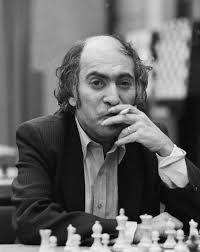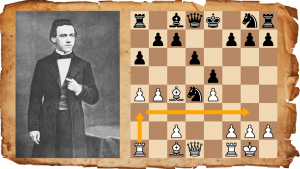Review: Mikhail Tal's Best Games 1 - The Magic of Youth
Mikhail Tal was one of the first world class players I saw in real life: as a kid, during my first visit to the Hoogovens chess tournament in Wijk aan Zee, I almost ran into him when I entered the playing hall.
Even this extremely brief encounter made a lasting impression on me. Later, when I started studying Tal's games, I became fascinated by the games and personality of the Magician of Riga. I always believed I had a pretty good knowledge of his chess games, but a new book on Tal's best games forced me to reconsider this.

GM Mikhail Tal
Mikhail Tal's Best Games 1 - The Magic of Youth, by Tibor Karolyi, is the first in a series, published by Quality Chess, of three volumes analysing the eighth World Champion's games to an unprecendented level of detail. In the words of the author himself:
"My objective in writing this series has been to document Tal's career and best games with a level of attention and thoroughness that has never previously been attempted. Apart from consulting the obvious databases and reading a lot of books, I also contact dozens of great players who shared their memories of Tal, both as a person and as an opponent."
The result of Karolyi's hard work is fascinating and, I must admit, completely addictive. While reading the first volume, covering the period 1949-1959, I felt compelled to take the book with me on a plane - a great inconvenience for someone who always insists on travelling as 'lightly' as possible - simply because I couldn't put it away.

Karolyi's approach to his subject (some years ago, he has written a similar series about Anatoly Karpov's games) is very appealing. He writes in an open, straightforward style and his analysis are precise and to the point. His research method is extremely thorough and betrays a profound interest the topic at hand. He doesn't give up easily if he stumbles upon historical facts that are not entirely clear, as the following fragment shows:
"Tal writes that he was fortunate to have an excellent trainer at the Pioneer Palace names Janis Kruzkops (...). I was unable to find any of Kruzkops' games on the database, but I managed to find out a bit more about him with the help of Gennady Sosonko, Alexander Bach and especially Alberts Cimins.
Kruzkops was born in Burtnieki on the 8th of March 1912. He was a strong Candidate Master, whose best tournament result saw him obtain the silver medal at the 1945 Latvian Championship. Curiously, the winner that year was Alexander Koblentcs, who would later become Tal's long-term trainer. (...) Thanks to Albert Cimins, I am able to share one game played by Tal's junior trainer."
Karolyi goes on to show and analyse the game (or, rather, a fragment of the game, since only the fist 21 moves have apparently survived) Kruzkops-Balins, Riga 1945 before remarking:
A single game does not prove anything definite, but it gives us an indication that Kruzkops was a skilled attacking player who may well have played a role in developing that aspect of Tal's game.
The book is full of such asides, where Karolyi deviates from his original goal (showing Tal's own games) in order to provide further context and background to his main story. By adopting this method of 'loose associations', he manages to shed new light even on well-known games such as the following (it is also given by Tal himself in his classic The Life and Games of Mikhail Tal:
"19.Rf6! Tal keeps attacking brilliantly, placing his rook on a square where it can be taken by two enemy pieces. Such a move would demonstrate good imagination from anybody, but it is especially remarkable for a thirteen-year-old boy. (...) By the way, the fourteen-year-old Kasparov echoed Tal's last move in a junior tournament in the Latvian capital.
30.Rf6! White went on to win in Kasparov-Pigusov, Riga 1977."
This is not, of course, a new way of writing about chess (hundreds of chess teaching books have been written around particular 'themes' such as the Rf1-f6 motif), but in a game collection it is not seen very often - unfortunately so.
Karolyi provides basic information about the major events in Tal's life both from a personal and chess-related perspective. Even if he doesn't write directly about Tal's career, it's still interesting to hear what he has to say:
"There is no complete record of Tal's games from any of the tournaments in which he partipated [in 1950]. (...) The policy of publishing the complete game record from the early years of a prominent player seems to have been standard practice in the Soviet Union. I noticed the same thing when working on the first volume of Karpov's Strategic Wins. In Karpov's case, there appears to have been an even stronger filter applied to the publication of his early games, which would have made them available for analysis by the general chess community. The loss of some score sheets may have been a contributing factor, but I do not consider it a full explanation. I find it more likely that the Soviet authorities did not want people to see the weaker, amateurish moves made by their stars in the early years. It is also possible that the players themselves did not want to publish too many of their early games. Whatever the reason, it is sad that we are left with only a small portion of these pieces of chess history."
True words indeed. However, fortunately for all chess fans, the book is mostly about Tal's fantastic chess games. Even for those familiar with the aforementioned The Life and Games of Mikhail Tal or Study Chess with Tal (originally published in 1978 as Schachtraining mit Ex Weltmeister Tal and recently published again by Batsford Chess), Karolyi's book will contain many new discoveries.
For example, I was enchanted by the following blitz (!) game, which I had never seen before.
Typically, Karolyi, isn't satisfied by showing this almost forgotten gem. He continues:
"I contacted the Polish chess historian Tomasz Lissowski, who was able to provide the following quote from Szukszta recalling the above experience:
'In the foyer, I played four blitz games against a very young Mikhail Tal. Max Euwe, who observed one game. wrote down the score and later published it, erroneously ascribing it to the Titovo Uzice 1955 tournament."
It is remarkable that such a great player as Euwe made notes on a junior player. Euwe was a friend of Koblencs, so he must have known about him."
It will come as no surprise that this book - all of its 440+ pages! - is full of such fantastic chess. I'd love to show you more, but for the purpose of this review, my point should be clear by now.
I may have been fortunate enough to catch a glimpse of the Latvian phenomenon when he was still alive. But 23 years after the man's death, the genius of Mikhail Tal lives on and his games continue to shine. Perhaps you think that's a terrible cliche, but then you clearly haven't read Tibor Karolyi's Mikhail Tal's Best Games 1- The Magic of Youth yet.



